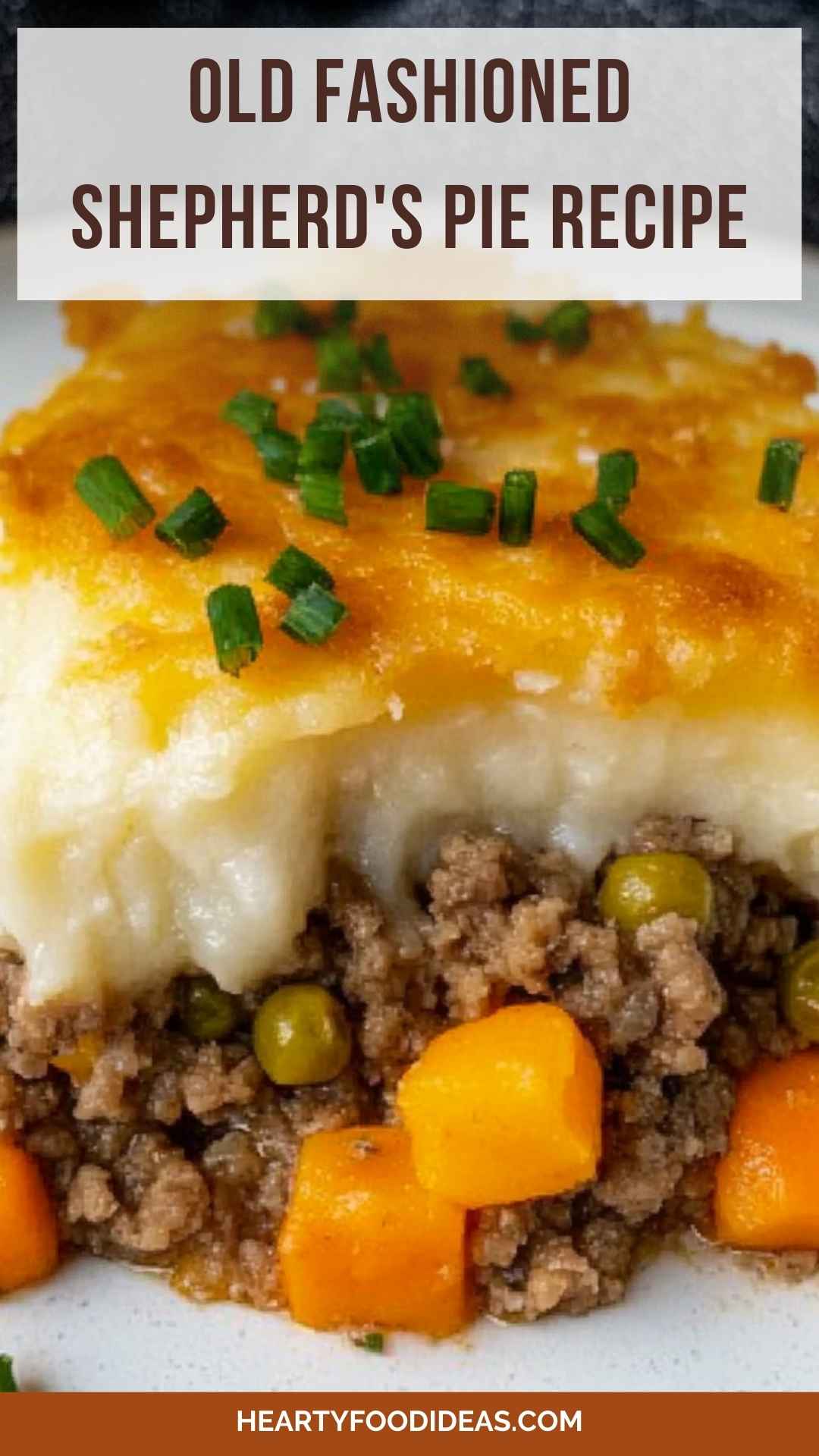Imagine walking through the narrow cobblestone streets of a quaint Italian village, the aroma of sizzling guanciale wafting through the air. Nothing quite screams comfort food like a plate of bucatini amatriciana.
This pasta dish, with its rich, savory sauce, warms the heart and satisfies the soul. Let me take you on a journey through this culinary delight, one that I believe deserves a spot in every home kitchen.
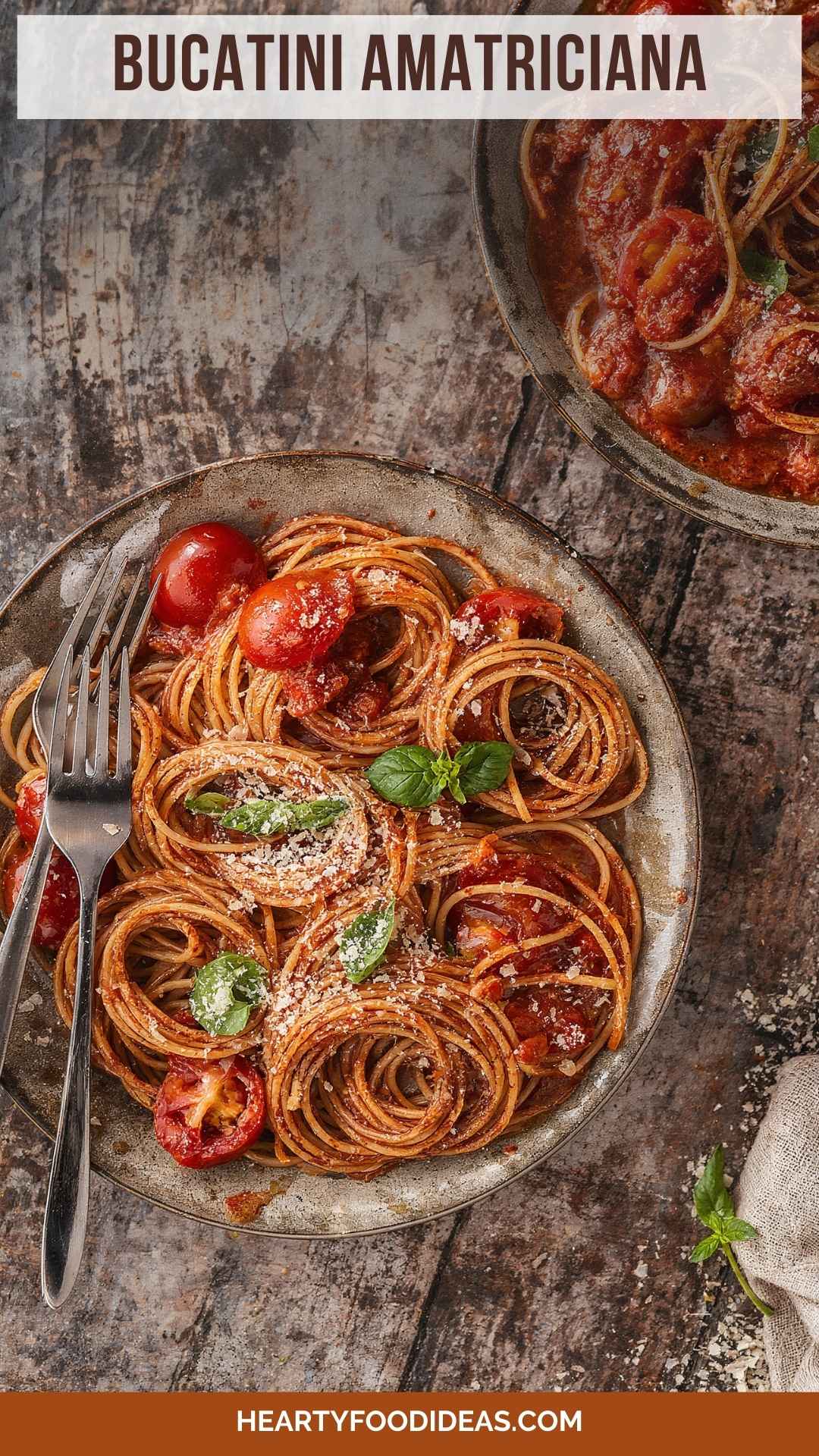
What is Bucatini Amatriciana?
At its essence, bucatini amatriciana is a classic Roman dish hailing from the town of Amatrice. It’s characterized by its simple yet deeply flavorful sauce made from guanciale (cured pork cheek), tomatoes, and Pecorino Romano cheese.
The magic lies in the ingredients. Each component plays a pivotal role in creating a perfect harmony of flavors. Traditionally served over bucatini, which is a thick spaghetti-like pasta with a hollow center, this dish not only fills the stomach but also captivates the palate.
Why You’ll Love This Bucatini Amatriciana
Imagine sinking your fork into pasta coated in a velvety sauce, flecks of crispy guanciale enticing you at every turn. It’s comforting yet sophisticated. You’ll love it for both its simplicity and its depth.
This dish requires minimal effort yet pays off with maximum flavor. Plus, it’s incredibly versatile. Whether you’re hosting a dinner party or whipping up a weeknight meal, bucatini amatriciana fits the bill perfectly.
The Ingredients
Before we dive into the cooking process, let’s gather our ingredients. The beauty of bucatini amatriciana is found in its simplicity. Here’s what you’ll need:
- 3 cans (14 ounces each) San Marzano whole or cherry tomatoes: These tomatoes bring a sweet, natural flavor.
- 1 pound bucatini pasta: The hollow shape holds the sauce beautifully.
- ¼ cup diced guanciale, pancetta, or unsmoked bacon: This adds that essential salty, savory kick.
- 2 fresh rosemary sprigs: For a hint of earthiness.
- ½ teaspoon crushed red chili flakes: A touch of heat never hurt anyone!
- 1 small shallot, finely minced: Adds subtle sweetness and depth.
- 1 tablespoon extra virgin olive oil: Use a good quality oil for the best flavor.
- Freshly ground black pepper, to taste: A finishing touch to elevate the dish.
- ¼ cup finely grated Pecorino Romano cheese: The crowning glory that ties everything together.
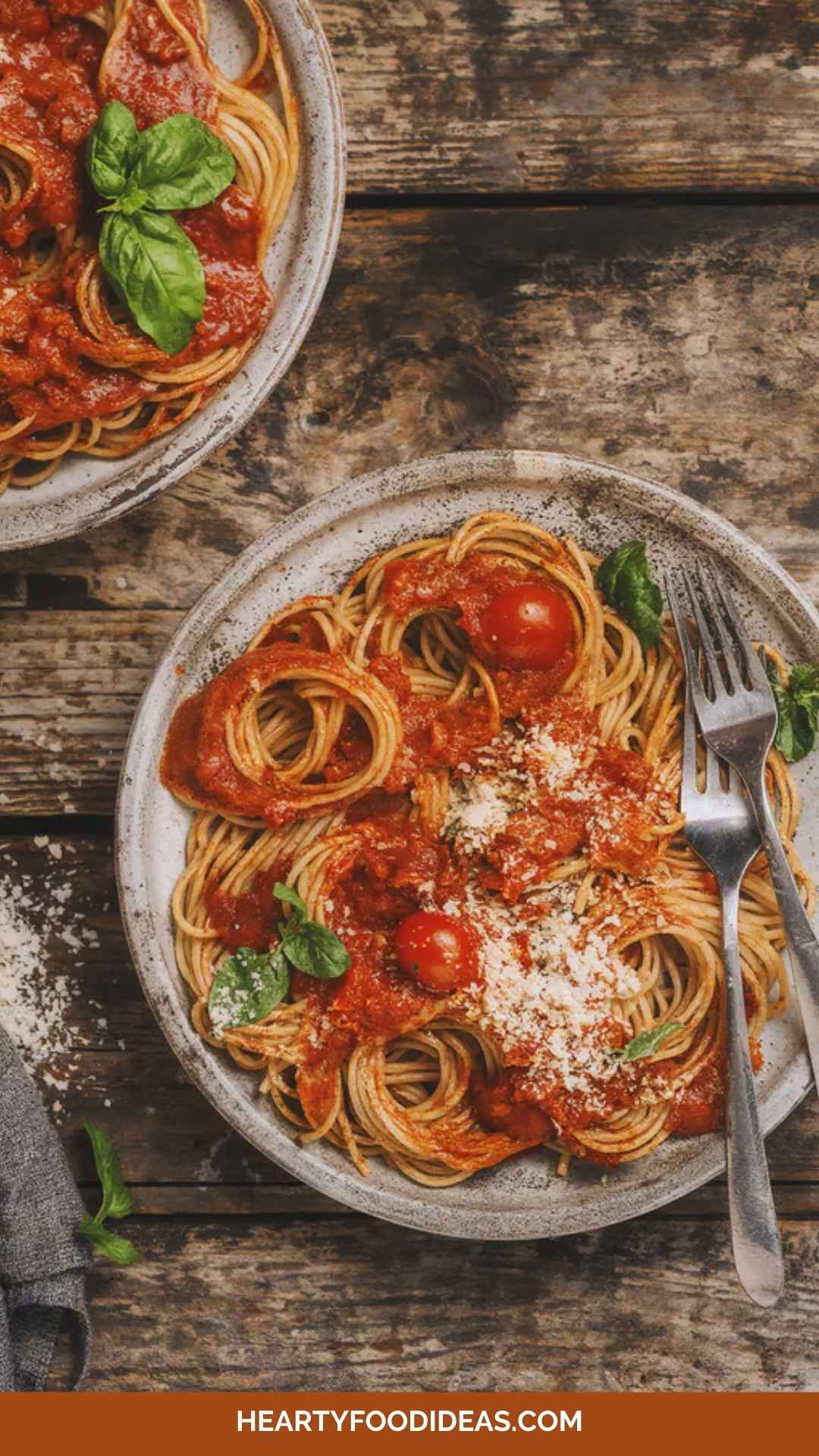
Step by Step Instructions
Now, let’s dive into the cooking process. Ready your pots and pans; it’s time to make some magic happen in the kitchen!
Step 1: Boil the Pasta
Start by filling a large pot with water. Bring it to a rolling boil. Make sure to salt it generously—like the sea! Toss in your bucatini and cook it until it’s al dente, which should take about 9 to 11 minutes, depending on the package instructions. Reserve about a cup of the pasta cooking water before draining.
Step 2: Sauté the Guanciale
While the pasta cooks, take a large skillet and heat it over medium heat. Add the diced guanciale (or pancetta). I can already hear that satisfying sizzle! Cook it until it’s crispy and golden, which usually takes about 5 minutes. Don’t rush this process; the key is to develop that rich flavor.
Step 3: Add Shallots and Rosemary
Once your guanciale is nice and crispy, toss in the minced shallot. Stir it around and watch it turn translucent. This usually takes about 2 minutes. Then, throw in those fragrant rosemary sprigs and crushed red chili flakes. The aroma filling your kitchen will whisk you away to Italy!
Step 4: Incorporate the Tomatoes
Next, pour in the San Marzano tomatoes. If you’re using whole tomatoes, crush them with a spoon as they hit the skillet. Bring the sauce to a gentle simmer and let it bubble away for about 10 minutes. This step allows the flavors to meld and develop. Stir occasionally, and don’t forget to season it with freshly ground black pepper!
Step 5: Combine Pasta and Sauce
Now, it’s time to unite the pasta and sauce. Once your bucatini is cooked, drain it (remember to reserve that lovely pasta water!). Add the pasta directly to the skillet with your sauce. Toss everything together, adding a splash of reserved water if necessary to help the sauce adhere to the pasta.
Step 6: Finish with Cheese
Finally, turn off the heat. Sprinkle the finely grated Pecorino Romano cheese over the top. Toss everything one last time until the cheese melts into the dish. Taste and adjust your seasoning if needed. You’re just about ready to serve!
Tips & Tricks
Here are some handy tips to make your bucatini amatriciana even better:
- Use high-quality ingredients: Quality guanciale and San Marzano tomatoes make a significant difference in flavor.
- Don’t Skip the Cheese: Pecorino Romano is traditional, but you can experiment with other cheeses.
- Leftover Pasta: If you have leftover sauce, try it with another type of pasta or as a base for a pizza.
- Adjust Heat Level: Control the chili flakes for a milder or spicier result.
- Fresh Herbs: Experiment with fresh basil for a twist!
Nutrition Information
Let’s take a moment to appreciate the nutritional aspect of bucatini amatriciana. Generally speaking, a standard serving might contain:
- Calories: Approximately 600
- Proteins: 25g
- Fats: 25g
- Carbohydrates: 70g
These values can vary based on your ingredient choices. It’s indulgent, but when enjoyed in moderation, it fits well within a balanced diet.
Can I Store Bucatini Amatriciana?
Absolutely! If you happen to have leftovers (though I doubt it), you can store them in an airtight container in the refrigerator. It should stay fresh for about 3 days. When it’s time to reheat, add a splash of water or broth to revive the sauce’s consistency.
What Can I Serve with Bucatini Amatriciana?
Bucatini amatriciana pairs wonderfully with a variety of sides. Here are a few ideas:
- Garlic Bread: Crunchy, buttery bread is always a hit.
- Mixed Greens Salad: A light salad dressed with a zesty vinaigrette balances the richness.
- Grilled Vegetables: Adds a nice smoky flavor and complements the pasta.
- Cheese Platter: Serve with a spread of cheeses and olives for a delightful appetizer.
- Wine: A glass of red Chianti elevates the whole dining experience.
Variations
While the classic recipe is undoubtedly delicious, here are five variations to keep things interesting:
- Spicy Shrimp Amatriciana: Add sautéed shrimp for added protein and flavor. The seafood complements the sauce beautifully.
- Vegetarian Amatriciana: Swap guanciale for roasted mushrooms or smoked eggplant. This keeps the umami flavor intact without meat.
- Cheesy Broccoli Amatriciana: Add steamed broccoli into the pasta for a healthier twist. The green color adds vibrancy and nutrition.
- Carbonara-inspired Amatriciana: Mix in egg yolks at the end for a creamy finish reminiscent of carbonara.
- Spaghetti alla Amatriciana: If you’re feeling adventurous, use spaghetti instead of bucatini for a different feel. The sauce still shines through!
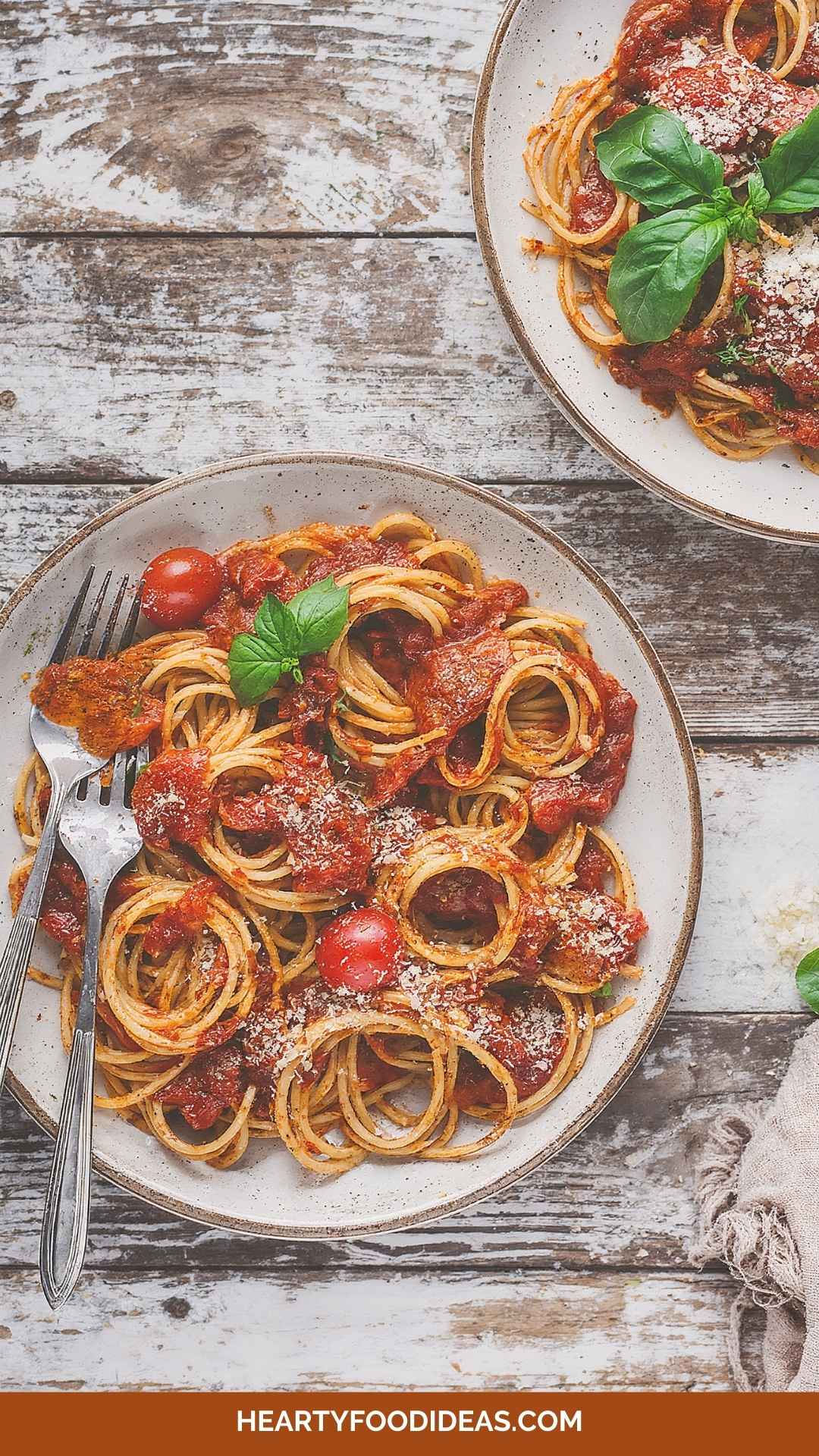
Conclusion
Bucatini amatriciana is more than just a meal; it’s an experience that captures the essence of Italian cuisine. With its rich flavors and simple preparation, it’s a dish that you can master quickly and serve with pride.
Whether you’re enjoying a cozy night in or celebrating with friends, this pasta will bring everyone together around the table. So roll up your sleeves, gather your ingredients, and get ready to indulge in a classic that’s guaranteed to impress! Buon appetito!
You’ll also like the following recipes!
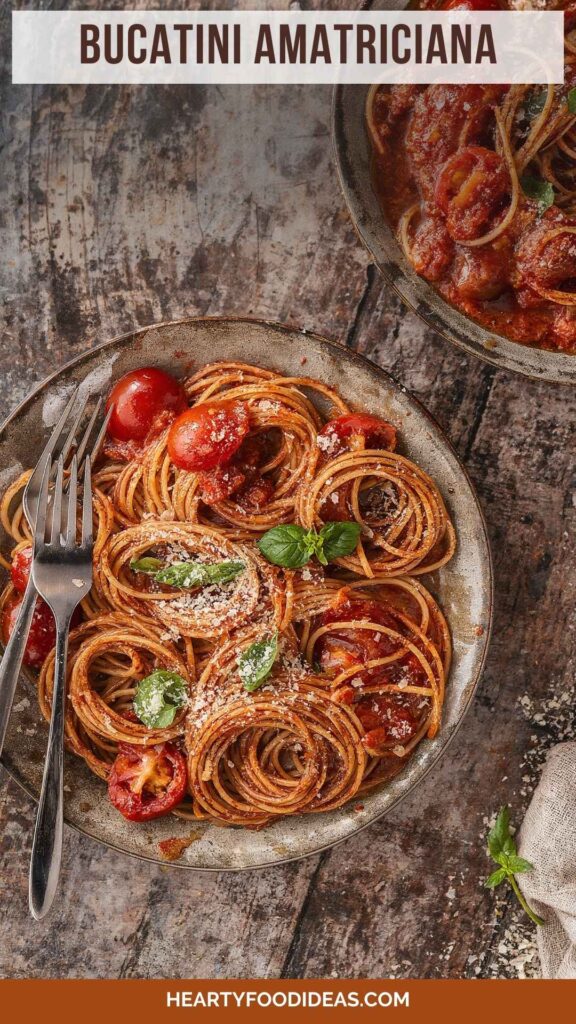
Bucatini Amatriciana – Hearty Food Ideas
Description
Imagine walking through the narrow cobblestone streets of a quaint Italian village, the aroma of sizzling guanciale wafting through the air. Nothing quite screams comfort food like a plate of bucatini amatriciana.
Ingredients
Instructions
Step 1: Boil the Pasta
-
Start by filling a large pot with water. Bring it to a rolling boil. Make sure to salt it generously—like the sea! Toss in your bucatini and cook it until it's al dente, which should take about 9 to 11 minutes, depending on the package instructions. Reserve about a cup of the pasta cooking water before draining.
Step 2: Sauté the Guanciale
-
While the pasta cooks, take a large skillet and heat it over medium heat. Add the diced guanciale (or pancetta). I can already hear that satisfying sizzle! Cook it until it's crispy and golden, which usually takes about 5 minutes. Don't rush this process; the key is to develop that rich flavor.
Step 3: Add Shallots and Rosemary
-
Once your guanciale is nice and crispy, toss in the minced shallot. Stir it around and watch it turn translucent. This usually takes about 2 minutes. Then, throw in those fragrant rosemary sprigs and crushed red chili flakes. The aroma filling your kitchen will whisk you away to Italy!
Step 4: Incorporate the Tomatoes
-
Next, pour in the San Marzano tomatoes. If you're using whole tomatoes, crush them with a spoon as they hit the skillet. Bring the sauce to a gentle simmer and let it bubble away for about 10 minutes. This step allows the flavors to meld and develop. Stir occasionally, and don’t forget to season it with freshly ground black pepper!
Step 5: Combine Pasta and Sauce
-
Now, it's time to unite the pasta and sauce. Once your bucatini is cooked, drain it (remember to reserve that lovely pasta water!). Add the pasta directly to the skillet with your sauce. Toss everything together, adding a splash of reserved water if necessary to help the sauce adhere to the pasta.
Step 6: Finish with Cheese
-
Finally, turn off the heat. Sprinkle the finely grated Pecorino Romano cheese over the top. Toss everything one last time until the cheese melts into the dish. Taste and adjust your seasoning if needed. You’re just about ready to serve!
Nutrition Facts
Servings 6
- Amount Per Serving
- Calories 600kcal
- % Daily Value *
- Total Fat 25g39%
- Total Carbohydrate 70g24%
- Protein 25g50%
* Percent Daily Values are based on a 2,000 calorie diet. Your daily value may be higher or lower depending on your calorie needs.
Note
- Use high-quality ingredients: Quality guanciale and San Marzano tomatoes make a significant difference in flavor.
- Don't Skip the Cheese: Pecorino Romano is traditional, but you can experiment with other cheeses.
- Leftover Pasta: If you have leftover sauce, try it with another type of pasta or as a base for a pizza.
- Adjust Heat Level: Control the chili flakes for a milder or spicier result.
- Fresh Herbs: Experiment with fresh basil for a twist!





